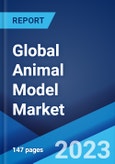The global animal model market size reached US$ 1.70 Billion in 2022. Looking forward, the market is expected to reach US$ 2.50 Billion by 2028, exhibiting a growth rate (CAGR) of 6.7% during 2022-2028.
Animal models are living, non-human species used in medical research and investigations. They are frequently selected due to their vast similarities with the genetics, anatomy, and physiology of humans. They assist in obtaining information about the prevention, diagnosis, and treatment of diseases without causing harm to a human. Some of the commonly utilized animal models include rodents, rats, mice, gerbils, guinea pigs, and hamsters. At present, they are widely preferred on account of their availability, ease of handling, and relatively low cost of use.
Animal models are living, non-human species used in medical research and investigations. They are frequently selected due to their vast similarities with the genetics, anatomy, and physiology of humans. They assist in obtaining information about the prevention, diagnosis, and treatment of diseases without causing harm to a human. Some of the commonly utilized animal models include rodents, rats, mice, gerbils, guinea pigs, and hamsters. At present, they are widely preferred on account of their availability, ease of handling, and relatively low cost of use.
Animal Model Market Trends
Presently, there is a continuous increase in the need for personalized medicines across the globe. This, in confluence with a rising prevalence of genetic disorders, such as down syndrome, Crohn’s disease, breast cancer, and hemophilia, represents one of the key factors positively influencing the utilization of animal models in the pre-clinical development of drugs by researchers. Apart from this, they are also being utilized in biomedical research, toxicology, physiology, cancer research, neurological research, genetic research, and xenotransplantation around the world. Furthermore, the market is propelled by numerous technological advancements, such as the introduction of CRISPR-Cas9, a genome editing technology, which aids in reducing the time and cost required for enabling the production of animal models with extensive genetic modifications. This technology finds wide applicability in a variety of animals, ranging from early-branching metazoans to primates. Besides this, the sudden outbreak of the contagious coronavirus disease (COVID-19) pandemic is creating a favorable outlook for the market. This can be accredited to the increasing investments by international organizations like World Health Organization (WHO) and government authorities in research and development (R&D) activities to introduce vaccines and antiviral drugs.Key Market Segmentation
This research provides an analysis of the key trends in each sub-segment of the global animal model market report, along with forecasts at the global, regional and country level from 2023-2028. The report has categorized the market based on animal type, technology, application and end user.Breakup by Animal Type:
- Rat
- Mice
- Guinea Pigs
- Rabbits
Breakup by Technology:
- CRISPR
- Embryonic Stem Cell Injection
- Nuclear Transfer
Breakup by Application:
- Drug Discovery and Development
- Basic Research
Breakup by End User:
- Pharma and Biotech Companies
- Academic Research Institutes
Breakup by Region:
- North America
- United States
- Canada
- Asia-Pacific
- China
- Japan
- India
- South Korea
- Australia
- Indonesia
- Europe
- Germany
- France
- United Kingdom
- Italy
- Spain
- Russia
- Latin America
- Brazil
- Mexico
- Middle East and Africa
Competitive Landscape
The competitive landscape of the industry has also been examined along with the profiles of the key players being Biocytogen, Charles River Laboratories International Inc, Envigo, Eurofins Scientific SE, GenOway S.A., Hera BioLabs, JSR Corporation, Ozgene Pty Ltd., PerkinElmer Inc., Taconic Biosciences Inc., The Jackson Laboratory and Trans Genic Inc.Key Questions Answered in This Report:
- How has the global animal model market performed so far and how will it perform in the coming years?
- What has been the impact of COVID-19 on the global animal model market?
- What are the key regional markets?
- What is the breakup of the market based on the animal type?
- What is the breakup of the market based on the technology?
- What is the breakup of the market based on the application?
- What is the breakup of the market based on the end user?
- What are the various stages in the value chain of the industry?
- What are the key driving factors and challenges in the industry?
- What is the structure of the global animal model market and who are the key players?
- What is the degree of competition in the industry?
Table of Contents
1 Preface3 Executive Summary12 Value Chain Analysis14 Price Analysis
2 Scope and Methodology
4 Introduction
5 Global Animal Model Market
6 Market Breakup by Animal Type
7 Market Breakup by Technology
8 Market Breakup by Application
9 Market Breakup by End User
10 Market Breakup by Region
11 SWOT Analysis
13 Porters Five Forces Analysis
15 Competitive Landscape
Companies Mentioned
- Biocytogen
- Charles River Laboratories International Inc
- Envigo
- Eurofins Scientific SE
- GenOway S.A.
- Hera BioLabs
- JSR Corporation
- Ozgene Pty Ltd.
- PerkinElmer Inc.
- Taconic Biosciences Inc.
- The Jackson Laboratory
- Trans Genic Inc.
Methodology

LOADING...
Table Information
| Report Attribute | Details |
|---|---|
| No. of Pages | 147 |
| Published | November 2023 |
| Forecast Period | 2022 - 2028 |
| Estimated Market Value ( USD | $ 1.7 Billion |
| Forecasted Market Value ( USD | $ 2.5 Billion |
| Compound Annual Growth Rate | 6.7% |
| Regions Covered | Global |
| No. of Companies Mentioned | 12 |









